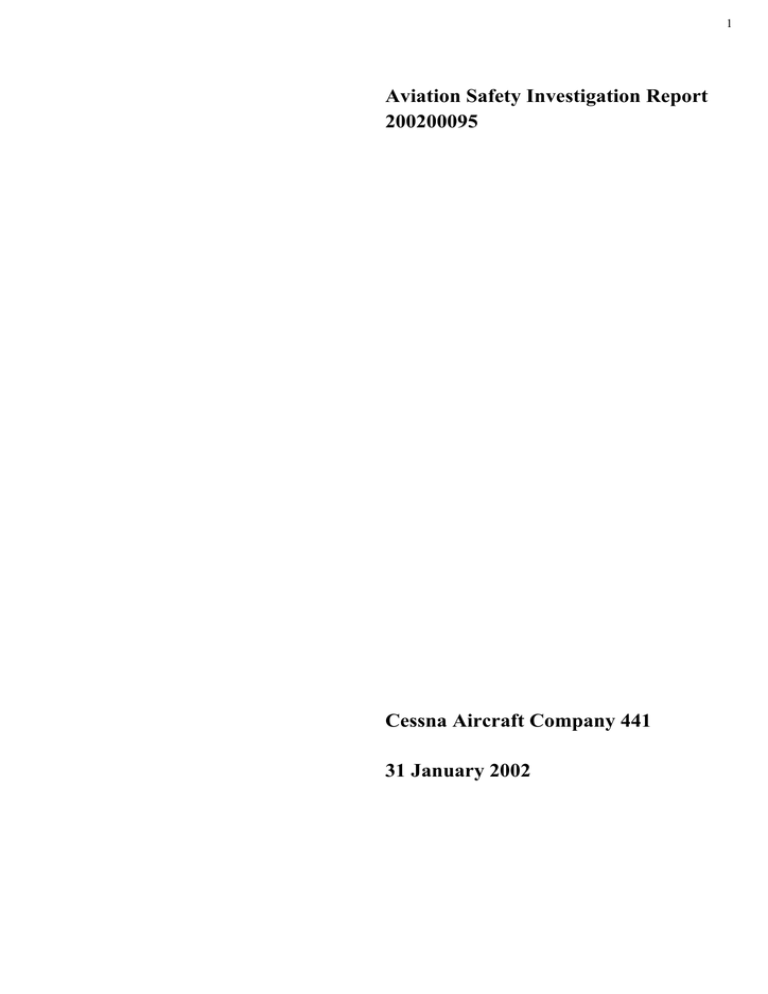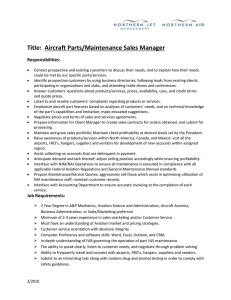Aviation Safety Investigation Report 200200095 Cessna Aircraft
advertisement

1 Aviation Safety Investigation Report 200200095 Cessna Aircraft Company 441 31 January 2002 2 Aviation Safety Investigation Report 200200095 _____________________________________________________________________________________________ Readers are advised that the Australian Transport Safety Bureau investigates for the sole purpose of enhancing transport safety. Consequently, Bureau reports are confined to matters of safety significance and may be misleading if used for any other purposes. Investigations commenced on or before 30 June 2003, including the publication of reports as a result of those investigations, are authorised by the CEO of the Bureau in accordance with Part 2A of the Air Navigation Act 1920. Investigations commenced after 1 July 2003, including the publication of reports as a result of those investigations, are authorised by the CEO of the Bureau in accordance with the Transport Safety Investigation Act 2003 (TSI Act). Reports released under the TSI Act are not admissible as evidence in any civil or criminal proceedings. NOTE: All air safety occurrences reported to the ATSB are categorised and recorded. For a detailed explanation on Category definitions please refer to the ATSB website at www.atsb.gov.au. 3 Aviation Safety Investigation Report 200200095 _____________________________________________________________________________________________ Occurrence Number: Location: Date: Highest Injury Level: Injuries: 200200095 222km NW Perth, VOR 31 January 2002 Nil Crew Ground Passenger Total Occurrence Type: Serious Incident Time: 1700 WST Fatal 0 0 0 0 Serious 0 0 0 0 Minor 0 0 0 0 None 0 0 0 Cessna Aircraft Company 441 VH-NFD Registration: Serial Number: 4410159 Non-commercial Aerial Operation Type: Ambulance Damage Level: Nil Departure Point: Karratha WA Departure Time: 1444 Jandakot WA Destination: Aircraft Details: Approved for Release: 29 October 2002 FACTUAL INFORMATION Shortly after commencing descent from flight level (FL) 310, the pilot of the Cessna Conquest noticed that the cabin altitude indication was rising. When passing through FL270, the cabin rate of climb rose to 3,000 ft/min with an accompanying decrease in cabin differential pressure and both master warning and "ALT" annunciators illuminating. When the annunciator lights illuminated, the pilot observed that the cabin oxygen masks had failed to auto-deploy as required. As the patients were already on oxygen and the flight nurse had donned a spare mask, he did not deploy them manually. The pilot donned his own oxygen mask and commenced a rapid descent to 10,000 ft. The pilot reported that the cabin altitude indication increased to a peak of 17,000 ft before decreasing during the descent. A subsequent maintenance inspection found water contamination present in the cabin door seal pressurisation solenoid valve and it was suspected that this water froze, preventing the correct operation of the valve. The failure of the oxygen mask auto-deployment system was also investigated and the wiring to the barometric activation switch was found to have a high resistance. This wiring was replaced. As a precaution, the wiring to the barometric switch that activated the cabin altitude annunciator warning light was also replaced. During these rectifications, the maintenance personnel discovered that there was no procedure published by the manufacturer to correctly adjust and test either barometric switch set-point after maintenance. Manufacturers' maintenance manual procedures A sampling of maintenance manual procedures for aircraft types, representative of the current Australian fleet and manufactured in countries such as the United States, United Kingdom and Switzerland was carried out. This 4 Aviation Safety Investigation Report 200200095 _____________________________________________________________________________________________ sampling concluded that the maintenance deficiency for test and return to service of the oxygen deployment and cabin altitude alert barometric switches, found in the occurrence aircraft maintenance procedures, was also apparent in all but one of the other aircraft type manufacturer's maintenance procedures. Regulatory requirements The regulations currently in force in Australia state that: `CASA must issue a type acceptance certificate for an aircraft manufactured in a foreign country, without making the type certificate subject to any conditions, if a foreign type certificate or equivalent document issued by the NAA of a recognised country is in force for aircraft of that type'. CASR 21.183 deals with the issue of standard certificates of airworthiness and does not state any requirement specific to these altitude warning and oxygen deployment systems, other than that the general manufacture and modification status must conform to the production certificate or type certificate of an NAA or approved modifications to those standards. CASA advised that, although CAO 108.26 was still in force, it was not actively applied by CASA during the Australian airworthiness certification process. CASA had introduced new legislation under CAR 22A and CAR 24 in 1990, later superseded by CASR 21.29A and CASR 21.183 respectively, that facilitated the entry to Australia of new types and models without having to comply with Australian design standards. This legislation abandoned the practice of applying Australian design standards to aircraft manufactured outside Australia and certificated in any of five major aviation countries. The Federal Aviation Administration (FAA), being the National Aviation Authority (NAA) of the United States and one of these recognised countries, has also promulgated amendments to FAR Part 25 and FAR Part 23 at amendment 23-17 that require cabin altitude warnings to trigger at 10,000 ft. CASA stated that the latest Australian legislation, in combination with the FAA Regulations, makes the requirements of CAO 108.26 Para 3.1 redundant. On 12 July 2002, in a further response to recommendation R20000289, CASA recognised that there was scope for confusion and advised that it was considering amending CAO 108.26 to delete all requirements except the operational requirements imposed by CAO 20.4 sub-section 3 and the specification for protective breathing equipment imposed by CAO 20.4 sub-section 10. The response also stated that if CAO 108.26 is amended, the background to the amendment will be explained in an article in `Flight Safety Australia'. ANALYSIS The absence of regular maintenance checks involving calibration and functional testing of the barometric switches to verify actual set-points for cabin altitude alert or oxygen deployment resulted in a situation where the continued integrity and proper operation of these emergency alerting and deployment systems could not be assured throughout the service life of the aircraft to which they were fitted. Upon examining the Australian legislation, it appeared that the intent by CASA was to override and supersede the still current requirements of CAO 108.26. This intent would not be readily apparent to members of the industry consulting them for direction. This confusion, and the fact that CAO 108.26 had not been rescinded with the introduction of CASR's 21.29A and 21.183, would lead to the assumption that all requirements under CAO 108.26 were still to be complied with. The amendment alluded to in the CASA 12 July 2002 letter should address this confusion. The ATSB will monitor that undertaking until it is accomplished. SAFETY ACTION 5 Aviation Safety Investigation Report 200200095 _____________________________________________________________________________________________ Local safety action Independently of the investigation, the operator introduced an engineering order that details the appropriate adjustment and test procedures to be carried out prior to return to service for these barometric switches in its Cessna Conquest aircraft. ATSB safety action As a result of the investigation, the following recommendations were issued on 3 July 2002: Recommendation 20020101 The Australian Transport Safety Bureau recommends that the Civil Aviation Safety Authority ensure the adequacy of the maintenance requirements for calibration, functional test and return to service of barometric pressure switches used to activate cabin altitude alerting systems in Australian registered pressurised aircraft engaged in the carriage of fare paying passengers. Recommendation 20020102 The Australian Transport Safety Bureau recommends that the Civil Aviation Safety Authority ensure the adequacy of the maintenance requirements for calibration, functional test and return to service of barometric pressure switches used to activate deployment of drop down passenger oxygen masks in Australian registered pressurised aircraft engaged in the carriage of fare paying passengers. Recommendation 20020103 The Australian Transport Safety Bureau recommends that the US Federal Aviation Administration ensure the adequacy of the maintenance requirements for calibration, functional test and return to service of barometric pressure switches used to activate cabin altitude alerting systems in pressurised aircraft engaged in the carriage of fare paying passengers and type certificated in the United States. Recommendation 20020104 The Australian Transport Safety Bureau recommends that the US Federal Aviation Administration ensure the adequacy of the maintenance requirements for calibration, functional test and return to service of barometric pressure switches used to activate deployment of drop down passenger oxygen masks in low capacity pressurised aircraft engaged in the carriage of fare paying passengers and type certificated in the United States. Recommendation 20020105 The Australian Transport Safety Bureau recommends that the UK Civil Aviation Authority ensure the adequacy of the maintenance requirements for calibration, functional test and return to service of barometric pressure switches used to activate cabin altitude alerting systems in low capacity pressurised aircraft engaged in the carriage of fare paying passengers and type certificated in the United Kingdom. Recommendation 20020106 The Australian Transport Safety Bureau recommends that the UK Civil Aviation Authority ensure the adequacy of the maintenance requirements for calibration, functional test and return to service of barometric pressure switches 6 Aviation Safety Investigation Report 200200095 _____________________________________________________________________________________________ used to activate deployment of drop down passenger oxygen masks in low capacity pressurised aircraft engaged in the carriage of fare paying passengers and type certificated in the United Kingdom. Recommendation 20020107 The Australian Transport Safety Bureau recommends that the European Joint Aviation Authorities (JAA) ensure the adequacy of the maintenance requirements for calibration, functional test and return to service of barometric pressure switches used to activate cabin altitude alerting systems in low capacity pressurised aircraft engaged in the carriage of fare paying passengers and type certificated in accordance with the Joint Aviation Regulations. Recommendation 20020108 The Australian Transport Safety Bureau recommends that the European Joint Aviation Authorities (JAA) ensure the adequacy of the maintenance requirements for calibration, functional test and return to service of barometric pressure switches used to activate deployment of drop down passenger oxygen masks in low capacity pressurised aircraft engaged in the carriage of fare paying passengers and type certificated in accordance with the Joint Aviation Regulations. Recommendation 20020109 The Australian Transport Safety Bureau recommends that the Australian Civil Aviation Safety Authority liaise with the United States Federal Aviation Administration, the United Kingdom Civil Aviation Authority and the European JAA on implementation strategies to address these safety deficiencies. CASA safety action In response to Recommendations 20020101 and 20020102, CASA issued airworthiness bulletins (AWB) 21-1 Issue 1 and 35-1 Issue 1 respectively. The ATSB reviewed the CASA action and considers that it meets the intent of the recommendations. These ATSB recommendations have therefore been classified CLOSED - ACCEPTED. United Kingdom CAA safety action In response to Recommendations 20020105 and 20020106, the UK CAA advised that their research revealed, apart from the example cited by the ATSB that complied, the only other UK built aircraft to which these recommendations could apply was no longer the responsibility of the UK CAA. The production of this aircraft had been moved to the United States and accompanying this, the type certificate responsibilities had been transferred to the US FAA. The ATSB recommendations 20020103 and 20020104 to the US FAA would capture this aircraft type. The ATSB recommendations 20020105 and 20020106 to the UK CAA have been classified CLOSED ACCEPTED. Any further responses to these recommendations will be published on the ATSB website www.atsb.gov.au.


